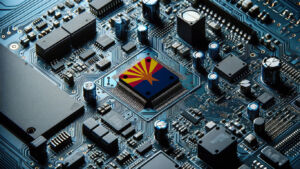As more and more Americans have been switching their gas-guzzlers for electric vehicles (EVs), the path to a greener future seems easier to walk. Essentially, electric vehicles have more than one feature working in their favor: They are quiet and generally much cheaper to “gas up,” all while helping us make a contribution to the welfare of the planet. Valley residents should be happy to know that Phoenix stands out as the 7th best metropolitan area in which to own electric cars.
As many as 1.8M electric vehicles were registered in the US in 2020, with consumer interest constantly on the rise. But universal EV implementation faces a few hurdles before going mainstream. The so-called “range anxiety” is one of them, and it refers to uncertain EV endurance on long-distance trips and also the lack of infrastructure that can help support a recharge in between big cities. Price can also be significantly off-putting for many potential buyers, even though studies show driving an EV is more cost effective in the long run. It’s true that federal, state and local incentives can help cushion the price for the general consumer, but an EV is still costly when compared to a regular car.
READ ALSO: ElectraMeccanica breaks ground on Mesa manufacturing facility
With challenges ahead, the electric vehicle trend is here to stay and in some places it’s thriving. Eco-friendly electric vehicles are ruling the streets of California, with some other less-hyped cities around the US taking great strides in EV adoption.
We set out to investigate which places are best suited to cater to the EV mindset and started by considering the most populous 100 metros. We analyzed metro areas taking into account a series of factors that promote EV take-up such as number of registered electric vehicles, EV infrastructure including public and residential charging stations, the cost of an eGallon (cost of charging a vehicle using electric when compared to a gasoline-powered one), dedicated HOV (high-occupancy vehicle) and HOT (high-occupancy toll) lanes for EVs, and the share of roads which are in poor condition.
We also included carpooling stats, local air quality, and an environmental indicator to gauge how much of a metropolitan area’s power comes from clean energy and how much of that is geared towards public transportation. Finally, we also added self storage availability as a metric, as putting vehicles in storage when they aren’t used is common practice for many multi-vehicle owners.
Here are a few key findings about the Phoenix metropolitan area:
• Phoenix ranks 7th in the U.S. for its number of electric cars (over 42,000 vehicles). Such an impressive number of EVs also needs the proper infrastructure, and Phoenix is prepared. There are over 570 public EV charging stations in Phoenix.
• Phoenix metro area is also the 14th most EV-friendly place for renters – about 5.6% of units in apartment buildings (17,900+ units) provide their residents with access to EV charging stations.
• Phoenix Metro is the best equipped nationally in terms of HOV lane access, as the metro dedicates 17.5% of all its freeway lanes, a total of about 390 lane miles, exclusively to EV usage.
CA’s San Jose, San Francisco and Los Angeles dominate the US “electric avenue”
As the financial and cultural center of Silicon Valley, the San Jose metro area is the ultimate electric car hotspot. Palo Alto in particular, which has been nurturing Tesla for quite some time now, serves as the hotbed of eco-friendly driving. San Jose claims not only the third-highest number of EVs in the country (approx. 74,000 electric cars), but also the third-largest number of EV charging stations (approx. 1,550), per Alternative Fuel Data Center data provided by the U.S. Department of Energy. San Jose also leads the way when it comes to the number of charging stations related to its population, with about 2.4 of them per 1,000 households, a lot higher than the national average of 0.3 EVs/1,000 households.
In an effort to bolster EV infrastructure expansion, San Jose works closely with state, county and regional authorities. Through the California Electric Vehicle Infrastructure Project (CALeVIP), the city seeks to incentivize the funding of electric vehicle implementation. The metro also boasts about 91 miles of HOV (high-occupancy vehicle) lanes, that’s about 10% of the metro’s total length of freeway lanes, to help support EV take-up. Thanks to its efforts to source clean energy and for using it in public transit, San Jose comes out as the seventh-most environmentally-friendly metro area.
With its tech-heavy industry and strong motivation to go green, San Francisco stands out as the second-best city for electric cars in 2021. Much like San Jose, electric vehicles are a common sight in the Bay Area. In fact, the metro boasts about 122,400 EVs, making The City by the Bay the second city based on its number of electric cars. Besides the federal and state efforts to promote the adoption of EVs, San Francisco also offers its residents incentives to go for greener vehicles through the Clean Cars for All grant program.
Such an impressive number of cars that run on electricity also need the proper infrastructure, and San Francisco doesn’t disappoint: With over 2,500 public charging stations, the San Francisco metro is second only to San Jose when population is factored in, with about 1.5 chargers/1,000 households.
Keeping in line with its traditions of recycling and composting, “the Silicon Valley of Recycling” also took strides to put in place the kind of infrastructure that promotes green vehicles on the road. The metro currently has about 290 miles of HOV lanes, about 15% of its total length of freeway lanes – the second largest share of lane mileage dedicated to electric cars in the country. Moreover, more than a third of public transit in San Francisco runs on clean fuel, helping the metro reduce its carbon footprint.
Maintaining California’s strong spirit of innovation and eco-consciousness, Los Angeles also crops up on the list of best metros for electric cars. The city’s sprawling landscape pushed Angelenos to speed up the adoption of EVs – which is eventually friendlier to both the environment and the wallet in the long run. In fact, LA comes first for the largest number of electric cars in the nation – over 230,900 of them – or about 13% of all US-registered EVs. There are plenty of options to charge your EV battery in LA at any of the 4,500+ charging stations available here. LA also ranks first nationally for its sheer number of charging stations. Correlated with population, the City of Angels comes sixth, with about 1 charging station/1,000 households.
The local infrastructure delivers too: There are currently about 730 miles of dedicated HOV lanes, which certainly encourages locals to get behind the wheel of an EV. 13% of the total freeway lane mileage has HOV lanes, which helps LA snag the fifth spot for this ranking.
A little south of LA, San Diego doesn’t disappoint when it comes to EV implementation: Per the latest data, about 51,000 electric vehicles are registered across San Diego, the fifth-largest concentration of EVs in the country. As EV technology has matured, the infrastructure here has too, with about 950 public charging stations available. Factoring in population, there are about 0.8 chargers per 1,000 households, placing San Diego on the eighth spot for EV distribution. And charging your EV is about to get even more convenient in America’s Finest City as about 2,000 new charging stations will be added at apartments and workplaces in the San Diego area, under a program funded by the California Public Utilities Commission.
Thanks to its concerted efforts to promote environmentally-conscious living, Phoenix, AZ, is another metro that scores highly for its electric car-friendliness. Phoenix came in seventh for the number of electric vehicles, with over 42,000 EVs registered in the metro area. With a considerable number of EVs, plug-in opportunities abound if your car needs an extra jolt. There are over 570 public EV charging stations in Phoenix and more are bound to be added. There are currently 0.3 charging stations per 1,000 households. Charging your EV is possible in about 6% of apartments, one of the highest rates of access to this service in the country. When Phoenix residents hit the road in their EVs, the metro is a shining example in terms of providing the necessary infrastructure. As it turns out, Phoenix is the best equipped nationally in terms of HOV lane access, as the metro dedicates 17.5% of all its freeway lanes, a total of about 390 lane miles, exclusively to EV usage. Furthermore, you can take advantage of federal, state and even city-level incentives if you purchase an EV in Phoenix.
Voted as one of the most prominent cities for green living, Portland emerges as another top hub for electric vehicles. About 27,500 registered EVs silently roam the streets of Portland, especially when the infrastructure is there to help their drivers make a convenient recharge: There are about 492 charging stations, landing the Portland metro area the tenth spot for EV infrastructure.
The metro’s commitment to green living has paid off as Portland is tops for its environmentally-oriented efforts. Breaking down the environment metric, Portland comes second nationally for the share of public transit vehicles (86%) powered by renewable energy. And for good reason too: The metro sources close to half of its power from renewable energy. This trickles down to the consumer as electric rates can be more affordable too under certain circumstances. Portlanders get discounted rates on electricity when they choose to charge their car overnight if they’re a Portland General Electric customer.
Putting innovation and eco-conscious living first, it’s easy to see why adoption of EVs is being encouraged both at a state and a local level in Oregon. Whether they’re buying or leasing an EV, locals can access federal, state and local incentives in Portland that they can use cumulatively if they choose to do so.
A city of many firsts, New York City, including the metropolitan area, is among the top hubs in the country for EV adoption as well. The NY metro is home to the fourth-highest number of electric vehicles – over 70,900 – which may soon become a staple of NYC traffic alongside the iconic yellow taxis. There are more than 1,460 charging stations to give your car an extra jolt. However, when we consider their distribution per population, the metro falls in the middle of the stack with about 0.2 charging stations/1,000 households. A big plus for EV owners in the NYC metro area is the single-driver access to about 130 miles of HOV lanes, which make up 1.7% of the metro’s freeway lane mileage.
Besides supporting drivers to adopt the EV lifestyle, the NYC metropolitan area has also taken further steps to go electric, as over 40% of the energy used to power public transit comes from renewable sources. About 2,000 electric vehicles were added to the on-road vehicle fleet, with a commitment to turn the entire City fleet electric by 2040. Going for an electric car in the NY metro comes with an array of perks that include state-level purchase incentives and reduced price for acquiring an EV.





